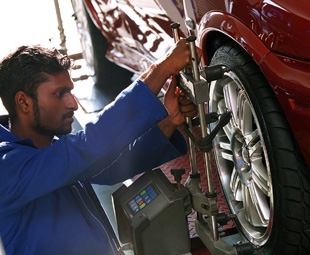Healthy tyres save lives!

Goodyear is advising motorists to give their tyres some much-needed attention after returning from a long distance journey over the holiday season. It’s not just speed that kills – damaged tyres are one of the main factors that contribute to accidents in South Africa.
Going on holiday is often a family affair – with a whole lot of luggage piled into the vehicle, every seat filled by eager bums and a caravan or trailer hitched to the back. Not only does this make the car more difficult to manoeuvre, it puts extra strain on the vehicle and tyres.
Lize Hayward, Goodyear brand communications manager, gives FOCUS some before and after holiday tyre tips to guarantee safe travelling. She stresses the importance of regular tyre check-ups for improved road safety.
“If the vehicle is fully loaded with passengers and luggage, the tyre pressure must be increased according to the car’s manual,” advises Hayward.
She adds: “Tyres are undoubtedly the most critical safety component on a vehicle as they affect traction, handling, steering, stability and braking.”
Hayward explains that when tyres are under-inflated, the car’s weight is concentrated on the outside part of the tyre tread, placing increased pressure on the sidewalls and affecting both performance and safety.
She reveals that studies carried out by the European Union have shown that more than 64 percent of all cars have under-inflated tyres. “Most drivers simply don’t check their tyre pressure often enough, which can have a significant effect on vehicle safety.”
 Tyres may lose up to 0.2 bar air pressure in a three-month period, solely as a result of the everyday diffusion processes in the tyre.
Tyres may lose up to 0.2 bar air pressure in a three-month period, solely as a result of the everyday diffusion processes in the tyre.
“Too many drivers make the mistake of thinking that a kick to their tyres or visual check will tell them if their tyre pressure is correct,” warns Hayward. “A visual inspection cannot detect a 0.2 bar decrease in pressure.”.
She also cautions drivers against checking the pressure when the tyre is warm as this results in incorrect readings: “Summer heat increases air pressure in tyres, so the pressure should be checked when the tyres are cold.”
Sufficient depth, even tread wear and any sidewall damage are the main aspects to look out for when completing a tyre check.
Hayward explains that both under inflation and over inflation have an effect on a tyre’s mileage, causing the tyre to wear out faster and in an uneven manner.
“Drivers should take care of their tyres as they should take care of all other important safety related items in the car,” she says.
Various tyre fitment centres confirm that potholes and deteriorating road conditions often cause vehicle and tyre damage. Some centres estimate that the number of tyres they replace due to road damage has doubled compared to a few years ago.
“Pothole damage is usually confined to tyres, rims, steering and suspension,” says Hayward. “If you hit a pothole and afterwards you notice a vibration, the steering wheel doesn’t centre properly or it pulls to one side, get the car checked immediately.”
She adds: “Faults such as tracking or steering damage can lead to later expense or even an accident. Watch out for the development of bulges on the tyre sidewalls, indicating serious internal damage. In this case, change the tyre immediately.”
Hayward advises motorists to be on guard for potholes, but not to suddenly swerve to avoid them – it could be very dangerous, potentially causing you to lose control.
Hi-Q, which has an extensive national footprint in both big cities and small towns, offers a free 10-point safety check on vehicles. Should any of the vehicle checks highlight a warning or faulty part, the technician will recommend the correct course of action.
Published by
Focus on Transport
focusmagsa




